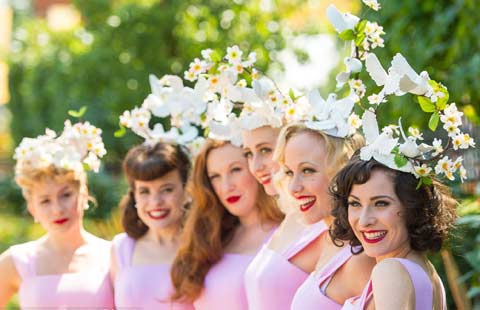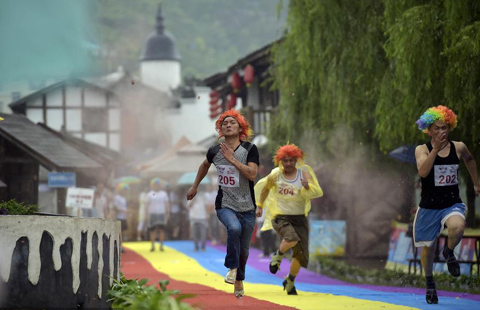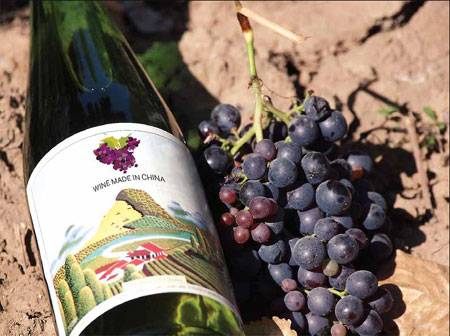Gan Bei!
Updated: 2012-06-03 07:59
By Pauline D. Loh and Cang Lide(China Daily)
|
||||||||
|
Photo Illustration by China Daily |
|
Yang Huafeng is one of the new breed of informed, educated winemakers in China. Cang Lide / China Daily |
A few dedicated Chinese vintners are putting grown-in-China, made-in-China wines on the map, a bottle at a time. Pauline D. Loh and Cang Lide visit a vineyard at scenic Puzhehei in Yunnan, while the China Daily Sunday team talks to experts about the good, bad and ugly of wines in China.
Are you going to Vinexpo, we asked Yang Huafeng, resident vintner of Sunspirit Wines from Yunnan's Puzhehei. No, he messaged back. "We are sitting at the foot of Meili snow mountains with friends, drinking, and almost drunk. I need to work at the vineyards the next few days, so will not be able to go to Hong Kong."
Yang has got his priorities and heart at all the right places.
Sunspirit Wines has a collection of vineyards at the foot of the Meili snow mountains in northern Yunnan, in Deqin, Shangri-La. Here, ethnic Tibetan farmers help them manage grape varietals that range from Riesling and Cabernet Sauvignon to the local Crystal White.
They also have a red grape called French Wild Grape, transplanted a long time ago by Jesuit missionaries to the area. So long ago, in fact, that no one remembers the varietal's actual name anymore.
Yang Huafeng, 42, is a rare species that has found growing appreciation among Chinese connoiseurs - the home-grown, home-trained vintner who cares about varietal, vintage and production according to the best viticulture practices.
Of course he would like to sell lots of wines, but he would not sacrifice quantity over quality.
The last harvest of Rieslings left on the vines until December produced some excellent icewine. But the bottles are not for sale. Not yet anyway.
Sunspirit currently produces a red icewine for sale, but each bottle commands a hefty four-figure price, and it's not exactly for the house wine market.
The label also does an enormous amount of experimenting and in Chateau Sunspirit, housed at Qiubei in Puzhehei about a six-hour, 280-kilometer ride from the Yunnan capital Kunming, a display of brandy, grappa, dark and light rum jostle for display space with red and white wine bottles.
It is, after all, still a transition period for a country raised on the tradition of throat-searing, super-charged baijiu, the white spirit brewed from grains that has alcoholic content hovering in the 50s and up.
But Sunspirit is doing all the proper things with its wines, starting with its Cabernet Sauvignon. This red could have come from either the best Australian vineyards or the Napa Sonoma, but it is grown right here. In Yunnan, China.
A lot of it has to do with the enlightened management practices of Sunspirit, and also the wine philosophy of its main motivators.
Chairman of the company is Liu Jiaqiang, who comes from Mengzi in Yunnan, in the Honghe Hani and Yi autonomous prefecture. It is an area known for determined traditions of ecological preservation.
Yang himself hails from a lot farther. In 1992, the Shandong native graduated with a degree in biological engineering from the Beijing College of Light Industry (now known as the Beijing University of Industry and Commerce).
He decided to work in the then infant wine industry around Beijing instead of returning to Shandong because he was courting a young lady then.
The lady who changed the course of his career, now his wife, also works for Sunspirit in its Kunming office currently.
Yang is into his seventh year with Sunspirit, and he runs the company as its general manager and senior engineer, looking after everything from planting to production.
Before that, he was apprenticed to some of China's best-selling wine-makers and labels, where he was exposed to both good and bad production practices.
But most important of all, Yang has traveled extensively to all the best wine growing regions in the world and has also seen and tasted the best and worst of viticulture.
His thirst for knowledge is manifested by his continuing quest, and Yang is currently doing a doctorate at the South China University of Technology.
All these has given Yang knowledge, options and a head start when he joined Sunspirit as part of its pioneer team.
Sunspirit was established in January 2005. Currently, it grows about 500 mu of grapes in Qiubei and gets additional fruit from more than 2,000 mu of co-operative vineyards around the region. That translates to about 166 hectares of vineyards.
The label also taps upon 10,000 mu of cool climate vineyards at the foot of the Meili snow mountain at Deqin, near Shangri-la and has plans to increase the acreage to 50,000 mu in the next few years.
They work mainly with ethnic Tibetan farmers who have a healthy respect for the land and who subscribe to ecologically friendly agricultural traditions.
Currently, Sunspirit's production capacity is about 3,000 metric tons at Qiubei with 240 oak barrels, both French and Californian. In Deqin, it can produce another 2,000 metric tons.
If you look at the numbers, you realize Sunspirit is not equipped for mass production right now. But it is slowly building up a formidable reputation through direct sales, mainly to corporate clients and government institutions. And it is preparing itself for bigger things to come.
What impresses us is the care and attention that goes into the growing and making, from the nurturing of transplanted varietals to the development of indigenous grapes.
Take the Crystal White, a wine made from a local grape. It is a cheap, prolific grape that some juice companies have actually used to make a juice drink characterized by an intensely sweet aroma. As for the wine, when the cork is popped, the bouquet wafts out, quickly perfuming the room.
We expected a sweet wine, maybe even cloying but instead, were pleasantly, very pleasantly surprised by a nice crisp, summery dry white.
It is so much of an eyebrow raiser because for long, Chinese winemakers have bottled sweet white wine, cheaply and abundantly, and flooded the supermarket shelves.
Another marketing trick is to give a red wine a French-sounding name and pass it off without telling the consumer either its grape variety or vintage.
Sunspirit makes none of these mistakes.
As the Chinese wine market matures, there are now more informed consumers. And they want to know local wine is safely grown, wisely managed and professionally made.
That's where vineyards and labels like Sunspirit will step in. They may be small now, but they are all pocket Hercules waiting for the space to mature into full-sized giants.
You can contact the writers at paulined@chinadaily.com.cn and canglide@chinadaily.com.cn.

 Ten photos you don't wanna miss - June 23
Ten photos you don't wanna miss - June 23
 The world in photos: June 15-21
The world in photos: June 15-21
 Kris Wu's long legs trigger envy
Kris Wu's long legs trigger envy
 School dropout farmer creates robots
School dropout farmer creates robots
 Typhoon Kujira makes landfall in S China
Typhoon Kujira makes landfall in S China
 Liu visits Houston Museum of Natural Science
Liu visits Houston Museum of Natural Science
 Liu meets Tsinghua Youth team in Houston
Liu meets Tsinghua Youth team in Houston
 Men get into women's shoes for fun
Men get into women's shoes for fun
Most Viewed
Editor's Picks

|

|

|

|

|

|
Today's Top News
Xi points way for Sino-US ties
Xi pins high hope for S&ED
China, US need 'common ground'
Liu challenges university leaders
10 chosen for Eisenhower fellowships
China unveils plans for V-Day parade
China-US talks to explore ways to make Xi's visit a success
Chinese consumers play big part in Apple's designs: Cook
US Weekly

|

|















